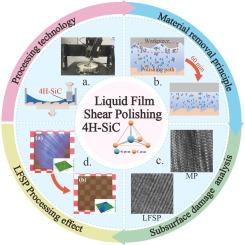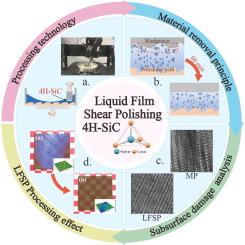一种新型碳化硅液膜剪切抛光技术及其加工损伤机理
IF 6.9
2区 材料科学
Q2 CHEMISTRY, PHYSICAL
引用次数: 0
摘要
作为第三代半导体材料,单晶4H-SiC具有高带隙、高击穿电压、高导热性和高电子迁移率等优异性能。但由于其显著的化学惰性和较高的硬度,加工后的表面质量往往较差,容易损坏,严重限制了高端设备的性能。为了解决这一问题,本研究提出了一种新型的液膜剪切抛光(LFSP)技术,以提高4H-SiC的表面质量并减少亚表面损伤(SSD)。采用扫描电镜、透射电镜、正电子湮没光谱、光致发光等方法,系统研究了抛光过程中材料的去除机理和微观组织演变,并对SSD行为进行了深入分析。结果表明,与机械抛光样品相比,LFSP样品具有更好的表面质量,并能有效去除固态金属。4H-SiC的材料去除率为25.6 nm/min,粗糙度Ra在60 min内从21.87 nm降至0.5 nm,损伤层厚度降至10 nm。研究表明,LFSP可以实现高质量、低损伤的4H-SiC抛光。本文章由计算机程序翻译,如有差异,请以英文原文为准。


A novel liquid film shearing polishing technique for silicon carbide and its processing damage mechanisms
As a third-generation semiconductor material, single-crystal 4H-SiC possesses exceptional properties such as high bandgap, high breakdown voltage, high thermal conductivity, and high electron mobility. However, due to its significant chemical inertness and high hardness, the surface quality after processing is often poor and prone to damage, which severely limits the performance of high-end equipment. To address this, this study proposes a novel liquid film shearing polishing (LFSP) technique to enhance the surface quality of 4H-SiC and reduce subsurface damage (SSD). By employing scanning electron microscopy, transmission electron microscopy, positron annihilation spectroscopy and photoluminescence, the material removal mechanism and microstructural evolution during polishing were systematically studied, and SSD behavior was analyzed in depth. The results demonstrate that, compared to mechanical polishing samples, the LFSP samples exhibit superior surface quality with effective removal of SSD. The material removal rate for 4H-SiC is 25.6 nm/min, with roughness Ra decreasing from 21.87 nm to 0.5 nm over 60 min, and the damage layer thickness reduced to 10 nm. This study indicates that LFSP can achieve high-quality, low-damage polishing of 4H-SiC.
求助全文
通过发布文献求助,成功后即可免费获取论文全文。
去求助
来源期刊

Applied Surface Science
工程技术-材料科学:膜
CiteScore
12.50
自引率
7.50%
发文量
3393
审稿时长
67 days
期刊介绍:
Applied Surface Science covers topics contributing to a better understanding of surfaces, interfaces, nanostructures and their applications. The journal is concerned with scientific research on the atomic and molecular level of material properties determined with specific surface analytical techniques and/or computational methods, as well as the processing of such structures.
 求助内容:
求助内容: 应助结果提醒方式:
应助结果提醒方式:


